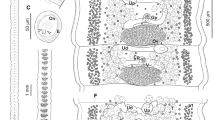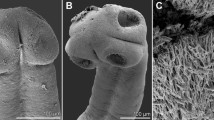Abstract
Two new species of bothriocephalidean tapeworms, Bothriocephalus australis n. sp. from the flatheads Platycephalus bassensis Cuvier (type host) and P. aurimaculatus Knapp off southern Australia and B. celineae n. sp. from a hybrid serranid Cephalopholis aurantia (Val.) × C. spiloparaea (Val.) from off New Caledonia, are described. B. australis is unique in the possession of the combination of the three characters: an elongate, obliquely situated cirrus-sac; a wide genital atrium surrounded by chromophilic cells; and a well-developed apical disc. B. celineae is typified by the presence of a low number of testes per segment (14–26), forming one or two incomplete longitudinal bands on each side of segment, and the small size of the strobila (total length 24 mm) which consists of less than 100 segments.
Résumé
Deux nouvelles espèces de cestodes Bothriocephalidea, Bothriocephalus australis n. sp. de poissons-crocodiles Platycephalus bassensis Cuvier (hôte-type) et P. aurimaculatus Knapp du Sud de l’Australie et B. celineae n. sp. d’un Serranidae hybride Cephalopholis aurantia (Val.) × C. spiloparaea (Val.) de Nouvelle-Calédonie, sont décrites. B. australis est défini par la combinaison unique de trois caractères: un sac du cirre allongé et situé obliquement, un atrium génital large entouré par des cellules chromophiles et un disque apical bien développé. B. celineae est caractérisé par la présence d’un petit nombre de testicules par segment (14–26) formant une ou deux bandes longitudinales incomplètes de chaque côté du segment, et la petite taille du strobile (longueur totale 24 mm) qui consiste en moins de 100 segments.



Similar content being viewed by others
References
Abdou, N. E.-S., & Palm, H. W. (2008). New record of two genera of trypanorhynch cestodes infecting Red Sea fishes in Egypt. Journal of the Egyptian Society of Parasitology, 38, 281–292.
Beveridge, I., Chauvet, C., & Justine, J.-L. (2007). Redescription of Pseudogilquinia pillersi (Southwell, 1929) (Cestoda: Trypanorhyncha) from serranid and lethrinid fishes from New Caledonia and Australia. Acta Parasitologica, 52, 213–218.
Brabec, J., Kuchta, R., & Scholz, T. (2006). Paraphyly of the Pseudophyllidea (Platyhelminthes: Cestoda): circumscription of monophyletic clades based on phylogenetic analysis of ribosomal RNA. International Journal for Parasitology, 36, 1535–1541.
Froese, R., & Pauly, D. (Eds.). (2009). FishBase. World Wide Web electronic publication. Version, accessed January 2009. http://www.fishbase.org.
Heemstra, P. C., & Randall, J. E. (1993). Groupers of the world (family Serranidae, subfamily Epinephelinae). An annotated and illustrated catalogue of the grouper, rockcod, hind, coral grouper and lyretail species known to date. Rome: FAO. FAO Species Catalogue. Fisheries Synopsis, 16 (125), 382 pp.
Hooper, J. N. A. (1983). Parasites of estuarine and oceanic flathead fishes (family Platycephalidae) from northern New South Wales. Australian Journal of Zoology, Supplementary Series, 31, 1–69.
Jordan, D. S., & Richardson, R. E. (1908). A review of the flat-heads, gurnards, and other mail-cheeked fishes of the waters of Japan. Proceedings of the United States National Museum, 33, 629–670.
Justine, J.-L. (2007). Pseudorhabdosynochus argus n. sp. (Monogenea: Diplectanidae) from Cephalopholis argus, P. minutus n. sp. and Diplectanum nanus n. sp. from C. sonnerati and other monogeneans from Cephalopholis spp. (Perciformes: Serranidae) off Australia and New Caledonia. Systematic Parasitology, 68, 195–215.
Justine, J.-L. (2008). Diplectanum parvus sp. nov. (Monogenea, Diplectanidae) from Cephalopholis urodeta (Perciformes, Serranidae) off New Caledonia. Acta Parasitologica, 53, 127–132.
Kuchta, R. (2007). Revision of the paraphyletic “Pseudophyllidea” (Eucestoda) with description of two new orders Bothriocephalidea and Diphyllobothriidea. PhD Thesis, Faculty of Biological Sciences, University of South Bohemia, České Budějovice, Czech Republic, 97 pp.
Kuchta, R., & Scholz, T. (2007). Diversity and distribution of fish tapeworms of the “Bothriocephalidea” (Eucestoda). Parassitologia, 49, 21–38.
Kuchta, R., Scholz, T., Brabec, J., & Bray, R. A. (2008a). Suppression of the tapeworm order Pseudophyllidea (Platyhelminthes: Eucestoda) and the proposal of two new orders, Bothriocephalidea and Diphyllobothriidea. International Journal for Parasitology, 38, 49–55.
Kuchta, R., Scholz, T., & Bray, R. A. (2008b). Revision of the order Bothriocephalidea Kuchta, Scholz, Brabec & Bray, 2008 (Eucestoda) with amended generic diagnoses and keys to families and genera. Systematic Parasitology, 71, 81–136.
Kuchta, R., Scholz, T., Vlčková, R., Říha, M., Walter, T., Yuniar, A. T., et al. (2009). Revision of tapeworms (Cestoda: Bothriocephalidea) from lizardfish (Saurida: Synodontidae) from the Indo-Pacific region. Zootaxa, 1977, 55–67.
McKinnon, A. D., & Featherston, D. W. (1982). Location and means of attachment of Bothriocephalus scorpii (Müller) (Cestoda: Pseudophyllidea) in red cod, Pseudophycis bacchus (Forster in Bloch et Schneider), from New Zealand waters. Australian Journal of Marine and Freshwater Research, 33, 595–598.
Palm, H. W. (2004). The Trypanorhyncha Diesing 1863. Bogor: IPB-PKSPL-Press, 710 pp.
Protasova, E. N. (1977). [Cestodes of fish – Bothriocephalata.] In: Osnovy tsestodologii, Vol. 8. Moscow: Nauka, 298 pp. (In Russian).
Randall, J. E., & Justine, J.-L. (2008). Cephalopholis aurantia × C. spiloparaea, a hybrid serranid fish from New Caledonia. The Raffles Bulletin of Zoology, 56, 157–159.
Renaud, F., Gabrion, C., & Romestand, B. (1984). Le complexe Bothriocephalus scorpii (Mueller, 1776). Différenciation des espèces parasites du Turbot (Psetta maxima) et de la Barbue (Scophthalmus rhombus). Étude des fractions protéiques et des complexes antigéniques. Annales de Parasitologie Humaine et Comparée, 59, 143–149.
Robert, F., & Gabrion, C. (1991). Experimental approach to the specificity in first intermediate hosts of bothriocephalids (Cestoda, Pseudophyllidea) from marine fish. Acta Œcologica, 12, 617–632.
Robinson, E. S. (1959). Records of cestodes from marine fishes of New Zealand. Transactions of the Royal Society of New Zealand, 86, 143–153.
Schmidt, G. D. (1986). CRC handbook of tapeworm identification. Boca Raton, Florida: CRC Press, Inc., 675 pp.
Scholz, T., Drábek, R., & Hanzelová, V. (1998). Scolex morphology of Proteocephalus tapeworms (Cestoda: Proteocephalidae), parasites of freshwater fish in the Palaearctic Region. Folia Parasitologica, 45, 27–43.
Scholz, T., & Hanzelová, V. (1998). Tapeworms of the genus Proteocephalus Weinland, 1858 (Cestoda: Proteocephalidae), parasites of fishes in Europe. Studie AV ČR, No. 2/98. Prague: Academia, 119 pp.
Škeříková, A., Hypša, V., & Scholz, T. (2004). A paraphyly of the genus Bothriocephalus Rudolphi, 1808 (Cestoda: Pseudophyllidea) inferred from internal transcribed spacer–2 and 18S ribosomal DNA sequences. Journal of Parasitology, 90, 612–617.
Yamaguti, S. (1959). Systema helminthum. Vol. 2. The cestodes of vertebrates. New York: Interscience, 860 pp.
Yuniar, A. T. (2005). Parasites of marine fish from Segara Anakan, Java, Indonesia and their possible use as biological indicators. Unpublished MSc thesis, Bremen University, Germany, 90 pp.
Acknowledgments
The authors are grateful to I. Dyková from the Institute of Parasitology, I. Beveridge from the University of Melbourne and K. Hutson from the University of Adelaide, Australia for providing material of cestodes, to Jan “Honza” Brabec for data on DNA sequences and to Martina Borovková, both the Institute of Parasitology, for technical assistance. In New Caledonia, S. Tereua and G. Colli participated to the fishing expedition and parasitological survey, and J. Randall (Bishop Museum, Hawai’i) and L. Knapp (Smithsonian, Washington) identified certain fish (from photographs). This study was partially supported by the Grant Agency of the Czech Republic (project No. 524/08/0885), Grant Agency of the Academy of Sciences of the Czech Republic (project No. KJB600960902), Institute of Parasitology (Z60220518 and LC522), Faculty of Science (MSM 6007665801) and National Science Foundation (Planetary Biodiversity Inventory project “A survey of the tapeworms (Cestoda: Platyhelminthes) from vertebrate bowels of the earth” to Janine N. Caira) (Nos. 0818696 and 0818823).
Author information
Authors and Affiliations
Corresponding author
Rights and permissions
About this article
Cite this article
Kuchta, R., Scholz, T. & Justine, JL. Two new species of Bothriocephalus Rudolphi, 1808 (Cestoda: Bothriocephalidea) from marine fish off Australia and New Caledonia. Syst Parasitol 73, 229–238 (2009). https://doi.org/10.1007/s11230-009-9184-8
Received:
Accepted:
Published:
Issue Date:
DOI: https://doi.org/10.1007/s11230-009-9184-8




